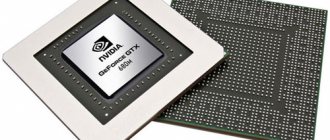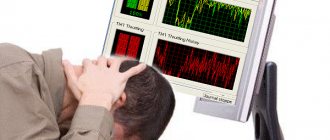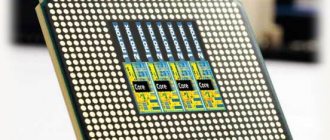If we take the purely specific characteristics of processors, then the clock frequency is the most well-known parameter. Therefore, it is necessary to specifically understand this concept. Also, within the framework of this article, we will discuss understanding the clock frequency of multi-core processors , because there are interesting nuances that not everyone knows and takes into account.
For quite a long time, developers relied on increasing the clock frequency, but over time, the “fashion” has changed and most of the developments go towards creating a more advanced architecture, increasing cache memory and developing multi-cores, but no one forgets about the frequency.
What is clock frequency
A processor is a chip that solves simple mathematical problems. After all, it is on them that the work of each program is built. Every second the CPU calculates, for example:
- changing the position of the cursor on the screen;
- video signal decoding (when playing media);
- calculation of the position of shadows of 3D objects (in running video games);
- calculation of the number of clusters required to save a file on the hard drive.
And the processor performs millions of such operations every second. And how many “examples” (in the form of binary code) it can solve in a second depends precisely on the clock frequency, which is indicated in the technical specifications as cpu frequency.
Frequency is measured in hertz. It should be taken into account that the higher it is, the more heat the CPU generates under load. The average frequency of modern processors ranges from 1.8 to 4.5 gigahertz (GHz).
That is, such crystals are capable of generating from 1.8 to 4.5 billion pulses in one second.
Can you tell a cringe from a crash? Take this fun test and find out!
We learned a lot today
You see a new game from Electronic Arts - expect a Frostbite engine inside and high processor requirements with a modest appetite for a video card.
If you see a game about “stalkers” - prepare a flagship video accelerator and CPU or tolerate reduced graphics detail. If you want to be Batman, prepare a powerful video card, but the adventures of the beautiful Lara Croft are also fraught with irrepressible consumption of video memory. If you love Battlefield, love Need for Speed (the performance is the same), but be prepared for the fact that for truly cool graphics in racing games you will need a video card no less cool than for shooters.
The old Ubisoft sandboxes are Ubisoft's voracious sandboxes. In new games, it is already possible to save on the processor.
GTA has long ceased to be a “crooked port from consoles” - an average computer with a graphics accelerator with three or four gigabytes of video memory is enough for it. Strategies on a PC are an unpredictable thing: some of them are designed by incompetent studios, so the games “slow down” on any components, some are remakes of old games that do not require powerful hardware.
And only massive online games (especially pay-to-win) will welcome PC players into open arms with hardware of almost any level. But all these conclusions do not answer the main question:
What does processor frequency affect?
The frequency of the processor directly affects its performance. The higher it is, the more operations the CPU can “process” in one second. For example, Pentium 4 converts video at a frequency of 1.5 GHz in 10 minutes. The same processor, but with a frequency of 3 GHz, will require about 2 times less time for the same operation - about 5 minutes.
But the final performance depends not only on frequency. It is significantly influenced by:
- Supported instruction sets (SSE, SSE2, AVX and so on). The CPU has built-in firmware that allows you to perform simple calculations using several different algorithms. This allows you to use processor resources more efficiently. A simple example: first the system analyzes a complex function, then simplifies it by dividing it into several simple ones. And the final calculation will take less time.
- Built-in cache memory. This is where the information being processed right now is loaded. The larger it is and the higher the memory bandwidth, the faster the processor performs calculations.
- Number of Cores. A single-core processor can only perform one task at a time. Accordingly, if you run 2 programs at once, it performs calculations for them one by one. Multi-core CPUs can process multiple threads simultaneously.
The maximum frequency of modern CPUs is variable. That is, it is adjusted depending on the required number of calculations performed. Why is this being done? To reduce the amount of current consumed as well as the heating temperature.
Read more: how to find out the processor temperature
There is also such a thing as “trotting”. This is a forced reduction in the maximum processor frequency due to overheating. It is a protective function that prevents the CPU from overheating (due to high temperatures, the silicon from which processors are made degrades).
M or F? Take the test and find out who you are in everyday life: are you a man or a woman?
Testing in synthetic programs: CPU-Z
Now that we have figured out the behavior of two instances in the stress test, I propose to compare the performance of processors in CPU-Z.
6 cores
4 cores
To simplify the perception of the test results, all data was displayed in the form of a diagram with a table of values.
The results of the “mathematical benchmark” were confirmed. The four overclocked cores, although they outperformed the six low-power cores in single-thread performance, were seriously inferior in multi-core performance. The slow six cores outperform the four fast ones by 12.5%, this difference was known in advance from the “mathematical benchmark”: the difference between 18 and 16 is 12.5%.
CPU-Z testing
How to find out the processor clock speed
You can find out the processor clock in the following ways:
- Press the keyboard shortcut Win+i
- Click on “System”
- Then move to the very bottom of the left list and select “About”. The processor clock speed will be indicated there.
- You can also unscrew the cover of the system unit, remove the CPU cooler and see the processor clock speed there by wiping off the thermal paste.
- On some models (mostly from Intel), the frequency is indicated on the thermal interface (the metal “cover” of the processor).
- Using special programs. For example, AIDA. You need to open the “System board” item in the side menu and select “CPU”. And in the “Motherboard” submenu, the processor bus frequency (FSB) is also indicated. This information will be useful when overclocking the CPU.
- Using the CPU-Z program. It provides maximum information about the installed CPU. That is, you can find out not only the frequency, but also the number of cores and cache memory size.
Volga or Pobeda? Are you familiar with the Soviet automobile industry? Test yourself in a fun test!
Energy consumption/noise/temperature testing
The processors were tested using the 10-minute OCCT test version 5.5.7 using AVX2 instructions.
To simplify the perception of the test results, all data was displayed in the form of a diagram with a table of values.
OCCT 5.5.7
Thus, in OCCT testing, a processor with six slow cores turned out to be cooler than a processor with overclocked four cores. But the results of this testing cannot be interpreted on the supposed Ryzen 5 3500X and Ryzen 3 3100/3300X. All processors are unique and this test only shows seriously increased heat dissipation rates with slight overclocking, which is typical for all Ryzen processors.
Do I need to change the clock frequency?
Modern motherboards have a function that allows you to slightly change the processor clock speed. It can be either lowered or increased. Why might this be needed? Either to reduce heating if the cooler cannot cope with cooling, or to increase performance.
In some CPUs, in this way you can increase the frequency from the original by even 30 - 40%.
Do I need to change the processor frequency on my computer? Sometimes this actually allows you to significantly increase productivity without any investment. You just need to take into account that this increases the heating of the CPU. And if its temperature often rises to 90 - 100 degrees, then this can lead to its failure.
That is, “overlocking” should only be done by those users who understand why they are doing it and take into account all the possible consequences.
On laptops, increasing the frequency is strictly not recommended. Their cooling systems are less efficient than on PCs. And sometimes the processor overheats even at base frequencies.
But it is possible to reduce it if the built-in BIOS provides such an opportunity. But keep in mind that productivity will decrease by the same 15 - 20%.
If the processor operates stably and its power is sufficient for the user, then it is better not to change the frequency settings. It is also worth mentioning that modern CPUs provide an automatic overclocking function.
For example, Intel refers to this technology as “Turbo-Boost”. That is, the CPU automatically increases the base frequency when performing resource-intensive calculations, but only if the heating of the crystal is not critical (does not exceed 85 - 90 degrees).
Take the test on the topic “Legends of the 90s”, remember which of these you had?
Artyom Sannnikov
The processor is one of the main components of a PC that performs all the basic calculations while the PC is running.
CPU (Central Processing Unit) - central computing device
APU (Accelerated Processing Unit) - accelerated computing device
The processor is a complex chip that consists of many blocks. The overall performance of the processor depends on the number and parameters of blocks. And the collection of these blocks and their configuration is called the processor architecture.
Processor Specifications:
- Processor performance and model
- Type of connector for connecting to the motherboard (socket)
- Number of physical cores
- Main processor frequency, frequency multiplier
- Processor bus frequency
- Built-in memory controller
- Supported memory type and its parameters
- Processor internal memory size
- Availability and parameters of the built-in video core
- Heat dissipation power
- Type of packaging
Processor performance and model
Intel and AMD do not produce processors, they only develop them. And other companies are already engaged in production, at the request of these development companies.
When a new processor is created on a new architecture, this architecture is given its own name to identify it. And then, within this architecture, a model range of processors is created: weak, medium and strong in performance.
Processors are most often divided according to the number of cores and frequency, and thus a range of proposals is obtained, a new architecture for creating computers of different performance based on this architecture.
Type of connector for connecting to the motherboard (socket)
The connector for connecting the processor to the motherboard is most often called a socket, and it determines the external dimensions of the processor, the number of pins, the method of attaching the processor to the motherboard, and the method of attaching the cooler to the processor.
This parameter must be taken into account when choosing a processor and motherboard, that is, the processor socket must be the same as the motherboard socket.
Number of physical cores
The processor core is a set of blocks that can independently process information.
1 core = 1 thread
The more cores a processor has, the more productive it will be. Under certain conditions, two threads of computation can be executed on one physical core:
1 core = 2 threads
In such processor models, the manufacturer separately indicates the number of physical cores and a separate number of logical cores, which are twice as many as physical ones.
This technology is used in some Intel processors (this technology is called Hyper Threading).
Processor clock speed
Clock frequency is a value that characterizes the number of operations performed by the processor per unit of time. Measured in hertz (Hz).
The higher the clock speed, the more powerful the processor. But this only works within processors of the same series.
Let's look at an example:
Intel Core i5-2400 3.10GHz/6MB
Intel Core i3-2120 3.3GHz/3MB
You would think that a 3.3GHz i3 series processor would be more powerful than a 3.10GHZ i5 series processor. Actually this is not true, the performance of the Core i5 series will be greater. because it has better other parameters. It has more physical cores and a larger cache size.
Modern processors can independently increase or decrease the frequency depending on the load on the processor, and this is done to more efficiently use the processor power. And their electricity consumption.
Thus, in addition to the main frequency, the characteristics also indicate the maximum frequency to which the processor can independently increase this parameter:
Processor frequency: 3.3 GHz (up to 3.9 GHz)
Intel calls this technology: Turbo Boost, and AMD calls it Turbo CORE.
Also associated with the frequency parameter is a parameter such as the multiplication coefficient.
Multiplier: locked/unlocked
This parameter is usually indicated in the detailed description of the processor, and physically it is one of the main parameters that determines the final processor frequency.
In simple processor models, this coefficient is fixed at one value, that is, locked; in processors for advanced users, this coefficient is unlocked. And thus, the user can independently adjust the processor frequency.
Processor bus frequency (system bus)
The bus frequency determines the speed of data exchange between the cores and the motherboard chipset, as well as other parts inside the processor.
Indicated in megahertz or transfers per second.
AMD FX-8120: HT 5.2 GT/s
Intel Core i5 2500: DMI 5GT/s
Intel pentium Dual-Core E5700: FSB 800MHz
The higher the data bus performance, the better it is for computer performance. For modern processors, this parameter has lost its relevance, as it was in processors of previous generations.
This is due to the fact that the data bus performance in modern processors is very high, and it can no longer reduce the overall performance of the computer, as it could in previous generations of processors, with a lower data bus frequency.
Built-in memory controller
All modern processors have it. It determines the type of RAM, the number of channels, and the standard frequencies for the processor to operate with memory.
For a home PC, a two-channel memory controller is sufficient; advanced users choose processors with three and four-channel controllers.
Supported memory type and its parameters
This parameter indicates what RAM the processor is designed to work with.
Type, frequency: DDR3-1066/1333
Max volume: 32 GB
Size of internal processor memory (cache)
Processor cache is high-speed memory built into the CPU and serves as a buffer between RAM and the processor.
The cache stores the data that the processor most often uses at the moment, and the processor does not need to access RAM for this data, which operates at a lower speed than the processor cache. And thus the overall performance of the processor increases.
In modern processors, the cache is divided into three levels:
- L1 cache: 64 KB x4
- L2 cache: 256 KB x4
- L3 cache: 6 MB
The size of the LI and L2 cache is determined by the parameters of the processor architecture, and L3 can be more or less arbitrary and comparable with other processors. Therefore, the characteristics of the processor most often indicate the size of the 3rd level cache; the larger it is, the better for processor performance. And usually more powerful processors have a larger level 3 cache.
Availability and parameters of the built-in video core
Modern processors may include a graphics core. This core provides processing and output of information to the monitor. This function is similar to the integrated video card in the motherboard.
Typically, the video core has its own operating frequency, which is much lower than the main operating frequency of the processor. And for the video core to work, part of the RAM is used - the size of which is determined in the motherboard settings.
Intel calls this core Intel HD Graphics XXXX, and AMD calls it Radeon HD XXXX. Where XXXX is a series of graphics cores, they differ in performance.
Heat dissipation power
TDP or “thermal package” is a value indicating how much thermal power the processor cooling system should be designed to remove.
Intel Core i5-2500: MaxTDP 95W
AMD FX 8120 Black Edition: Max TDP 125W
Many people mistakenly associate this parameter with the power consumption of the processor and use it when choosing a power supply. This parameter must be taken into account when choosing a processor cooling system.
The power consumption of the processor is usually within this thermal envelope, but it can be either more or much less than this parameter. Therefore, it is not entirely correct to take it into account when choosing a power supply!
When choosing a power supply, you can adhere to the following values:
Typically, the processor power consumption is within 100 Watts, but in order for us to have a power reserve for maximum loads, this parameter - the thermal package can be multiplied by 2. And the already obtained value should be taken into account when choosing a power supply.
Type of packaging
The processor can be sold with or without a standard cooling system.
A typical cooling system or cooler is designed to operate the processor in normal modes, that is, without additional user settings. This cooler is easy to install, but can make noise when the processor is under load.
If the processor is sold together with a cooler, then the word “BOX” is indicated in the characteristics, which tells us about the presence of a box. Inside which is the processor and cooler.
If the word “BOX” is not in the description, or the word “Tray” is indicated, this means that only the processor is for sale.
Tags : Knowledge base, Processor.
The importance of RAM and cache memory when choosing a processor for a laptop
Another fundamentally important parameter for assessing performance is the amount of cache memory built into the processor. The fact is that the exchange of information between processor cores and cache memory is much faster than with RAM (random access memory). As a result, the larger the cache size, the faster your processor ends up being. Moreover, in real tasks, a large cache size is needed more often than additional cores or too high a frequency. However, the larger the cache memory, the more expensive the processor is . In addition, increasing memory leads to heating of the processor.
If we talk about a specific purchase, then when choosing a processor of the same series and line for multimedia systems and workstations, preference should be given to those with a larger cache memory.
Why do processors with turbo boost have advantages?
The main advantage of such a processor is that it speeds up the computer under heavy load. If you are running a video game or a demanding application, your processor automatically increases the boost clock speed and provides maximum performance. This means better performance when it matters.
Additionally, Turbo Boost is a completely automatic process: your processor overclocks itself, without any intervention from you. It just works, so everyone benefits, whether you're a home user with no computer experience or a professional who works with enterprise applications that require a lot of processing power.
Executing Instructions
Instructions are stored in RAM in sequential order. For a hypothetical processor, an instruction consists of an opcode and a memory/register address. Inside the control device there are two instruction registers into which the instruction code and the address of the currently executing instruction are loaded. The processor also has additional registers that store the last 4 bits of executed instructions.
Below is an example of a set of commands that sums two numbers:
- LOAD_A 8. This command stores data in RAM, say <1100 1000>. The first 4 bits are the operation code. It is he who defines the instructions. This data is placed in the instruction registers of the control unit. The command is decoded into the load_A instruction - place data 1000 (last 4 bits of the command) into the A register.
- LOAD_B 2. A situation similar to the previous one. This places the number 2 (0010) in register B.
- ADD B A. The command sums two numbers (more precisely, it adds the value of register B to register A). The controller tells the ALU to perform the addition operation and put the result back into register A.
- STORE_A 23. We save the value of register A into memory cell with address 23.
These are the operations needed to add two numbers.
Information storage - registers and memory
As mentioned earlier, the processor executes the commands it receives. Commands in most cases work with data, which can be intermediate, input or output. All this data, along with instructions, is stored in registers and memory.
Registers
A register is the minimum data memory cell. Registers consist of flip-flops (latches/flip-flops). Triggers, in turn, consist of logical elements and can store 1 bit of information.
Note translation Triggers can be synchronous or asynchronous. Asynchronous ones can change their state at any time, and synchronous ones only during a positive/negative drop at the synchronization input.
According to their functional purpose, triggers are divided into several groups:
- RS trigger: retains its state at zero levels on both inputs and changes it when one of the inputs is set to one (Reset/Set).
- JK flip-flop: identical to the RS flip-flop, except that when units are supplied to two inputs at once, the flip-flop changes its state to the opposite (counting mode).
- T-flip-flop: reverses its state at every clock cycle on its only input.
- D-flip-flop: remembers the input state at the moment of synchronization. Asynchronous D-flip-flops make no sense.
RAM is not suitable for storing intermediate data, as it will slow down the processor. Intermediate data is sent to registers via the bus. They can store commands, output data, and even addresses of memory cells.
Operating principle of an RS trigger
Memory (RAM)
RAM (random access memory, English RAM) is a large group of these same registers connected together. The memory of such storage is unstable and data from there disappears when the power is turned off. RAM receives the address of the memory cell in which the data needs to be placed, the data itself, and the write/read flag that activates the flip-flops.
Note translation RAM can be static and dynamic - SRAM and DRAM, respectively. In static memory, the cells are flip-flops, and in dynamic memory, the cells are capacitors. SRAM is faster and DRAM is cheaper.
Two main components of the processor
Control device
The control unit (CU) helps the processor control and execute instructions. The control tells the components exactly what to do. Based on instructions, it coordinates with other parts of the computer, including the second major component, the arithmetic logic unit (ALU). All instructions are first sent to the control device.
There are two types of control implementation:
- Hardwired control units. The nature of the operation is determined by the internal electrical structure - the design of the printed circuit board or crystal. Accordingly, modification of such a control system without physical intervention is impossible.
- microprogrammable control units. Can be programmed for certain purposes. The software part is stored in the memory of the control unit.
A controller with hard logic is faster, but a controller with microprogram control has more flexible functionality.
Arithmetic logic unit
This device, oddly enough, performs all arithmetic and logical operations, such as addition, subtraction, logical OR, etc. The ALU consists of logical elements that perform these operations.
Linux school from CROC
April 1, Moscow, Free
tproger.ru
Events and courses on tproger.ru
Most logic gates have two inputs and one output.
Below is the circuit of a half adder which has two inputs and two outputs. A and B here are inputs, S is output, C is carry (to the most significant bit).
Arithmetic half-adder circuit
Manufacturers call Turbo Boost differently
Both AMD and Intel have technologies that control the base frequency of their processors and turbo boost speeds. For its latest series of computer processors (Ryzen 2000 and Ryzen 3000), AMD calls it Precision Boost 2. You can see a few details about it in the screenshot below.
Starting with the second generation Intel Core i5 and i7, Intel uses Intel Turbo Boost Technology v.2.0, and for the latest Core i7 and i9 processors, Intel Turbo Boost Max Technology v3.0.











